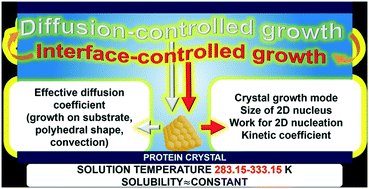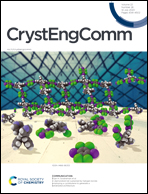Temperature-dependent growth of protein crystals with temperature-independent solubility: case study of apoferritin†
Abstract
The crystal growth of apoferritin, a protein with negligible temperature dependence of solubility, was investigated in the temperature range of 10–60 °C. An approach which accounts simultaneously for both the interface control and the diffusion limitation of crystal growth in solutions was applied. These two contributions were separately and successfully determined from the experimental data obtained with time-lapse microscopy. It was found that the effective diffusion coefficient of the apoferritin at different temperatures is at least 1.5 times smaller than that predicted by the Stokes–Einstein equation. Analysis of the contribution of interface control revealed that the apoferritin crystal growth proceeded via a nucleation-mediated mechanism rather than in spiral or normal growth mode. The temperature dependence of the size of the 2D nucleus and the work for its formation were determined. The obtained kinetic coefficient indicated that the diffusion-limited growth could become pronounced even for crystals of sizes as small as 20 μm. It also predicted a loss of polyhedral stability at a larger crystal size, although it was not observed experimentally. Finally, a comparative analysis was performed with respect to the time for crystals to grow to a detectable crystal size. This suggested that the lowest crystallization temperature could favor time-consuming processes of polymorph selection.



 Please wait while we load your content...
Please wait while we load your content...